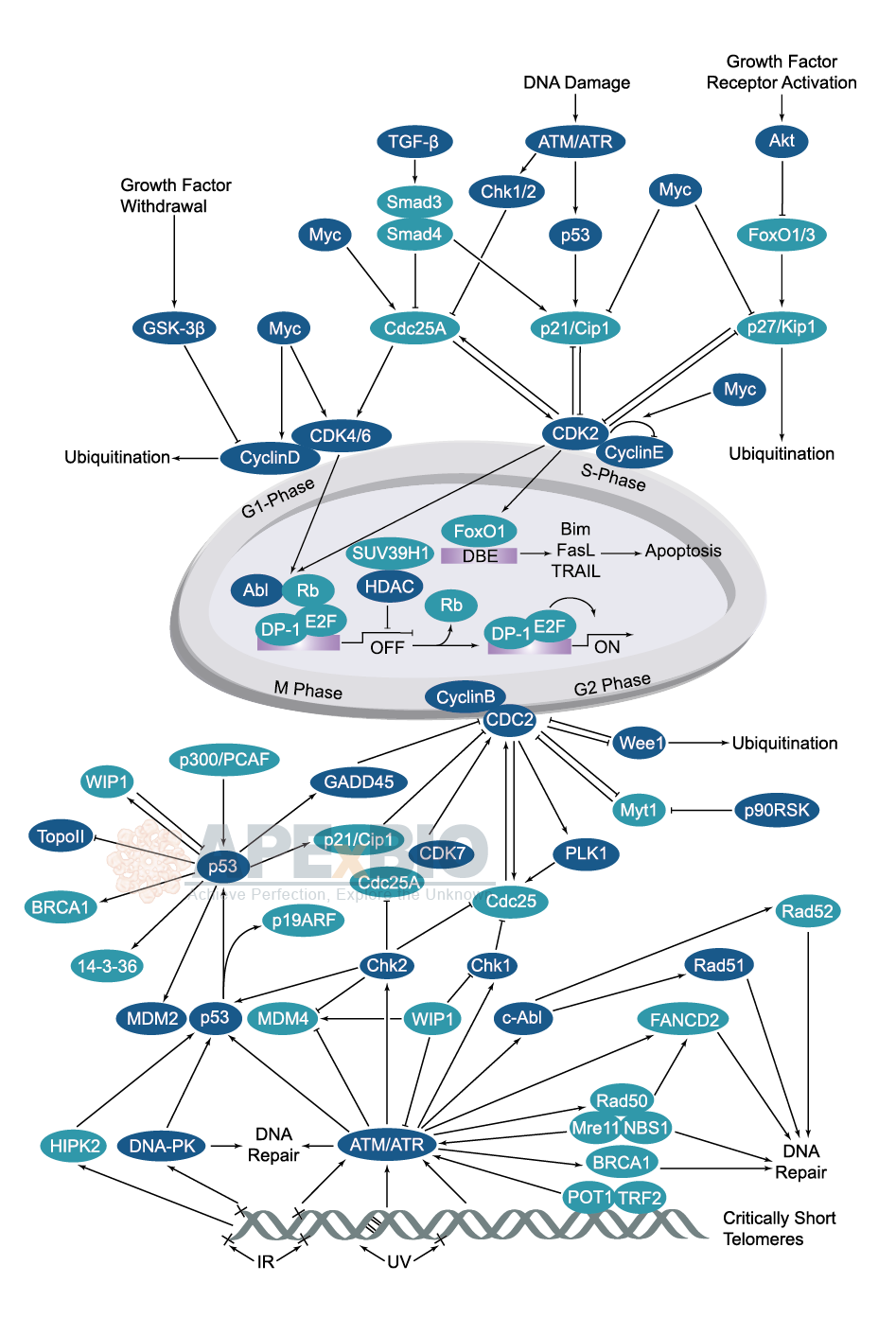Cell Cycle/Checkpoint


The cell cycle is consisted of 4 main phases: Gap 1 (G1), DNA replication (S), Gap 2 (G2), and mitosis (M). There are “checkpoints” mechanism regulates the transition between these phases, at the G1/S boundary, in the S-phase and during G2/M phases. Cell can only pass through these checkpoints when signaling factors are activated and free of DNA damage. Important proteins that control cell cycle events and checkpoints are cullins, cyclins, cyclin-dependent kinases (Cdks), p53 and their inhibitors etc. Cdks family (Cdk2, Cdk3, Cdk4 and Cdk6) are Ser/Thr kinases that regulate cell cycle progression in association with cyclin binding partners (cyclin D, cyclin E and cyclin A) during all four phases. p53 halts the cell cycle if the DNA is damaged and allowing time for DNA repair to progress; it can also initiate apoptosis if DNA damage is too severe to be repaired.
-
 BA7765 CaffeoyltryptophanSummary: Caffeoyltryptophan is a competitive inhibitor.
BA7765 CaffeoyltryptophanSummary: Caffeoyltryptophan is a competitive inhibitor. -
 BA7866 CKK-E12Summary: CKK-E12 is an ionizable lipid that combines with other lipids to form lipid nanoparticles for delivery of RNA-based studies.
BA7866 CKK-E12Summary: CKK-E12 is an ionizable lipid that combines with other lipids to form lipid nanoparticles for delivery of RNA-based studies. -
 BA5870 RBN013209Summary: RBN013209 is a potent inhibitor.
BA5870 RBN013209Summary: RBN013209 is a potent inhibitor. -
 BA5944 VudalimabSummary: Vudalimab is a potent and dual inhibitor, a fully humanized bispecific monoclonal antibody.
BA5944 VudalimabSummary: Vudalimab is a potent and dual inhibitor, a fully humanized bispecific monoclonal antibody. -
 BA5947 TuvonralimabSummary: Tuvonralimab (PSB-205; QL1706) is a dual immune checkpoint blocker.
BA5947 TuvonralimabSummary: Tuvonralimab (PSB-205; QL1706) is a dual immune checkpoint blocker. -
 BA6140 CA-170Summary: CA-170 is an oral dual inhibitor.
BA6140 CA-170Summary: CA-170 is an oral dual inhibitor. -
 BA6145 LatikafuspSummary: Latikafusp (AMG256) is a bifunctional fusion protein containing targeted antibodies and mutant proteins designed to provide pathway stimulation to PD-1+ cells.
BA6145 LatikafuspSummary: Latikafusp (AMG256) is a bifunctional fusion protein containing targeted antibodies and mutant proteins designed to provide pathway stimulation to PD-1+ cells. -
 BA6146 AcasunlimabSummary: Acasunlimab (GEN1046) is a bispecific antibody (bsAb) that targets and.
BA6146 AcasunlimabSummary: Acasunlimab (GEN1046) is a bispecific antibody (bsAb) that targets and. -
 BA6147 D18Summary: D18 is an immunomodulator.
BA6147 D18Summary: D18 is an immunomodulator. -
 BA6149 TPP-1Summary: TPP-1 is a potent inhibitor of the interaction.
BA6149 TPP-1Summary: TPP-1 is a potent inhibitor of the interaction.


